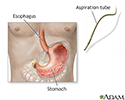Stomach acid test
Gastric acid secretion test
The stomach acid test is used to measure the amount of acid in the stomach. It also measures the level of acidity in stomach contents.
How the Test is Performed
The test is done after you have not eaten for a while so fluid is all that remains in the stomach. Stomach fluid is removed through a tube that is inserted into the stomach through the esophagus (food pipe).
A hormone called gastrin may be injected into your body. This is done to test the ability of the cells in the stomach to release acid. The stomach contents are then removed and analyzed.
How to Prepare for the Test
You will be asked not to eat or drink for 4 to 6 hours before the test.
How the Test will Feel
You may have some discomfort or a gagging feeling as the tube is inserted.
Why the Test is Performed
Your health care provider may recommend this test for the following reasons:
- To check if anti-ulcer medicines are working
- To check if material is coming back up from the small intestine
- To test for the cause of ulcers
Normal Results
The normal volume of the stomach fluid is 20 to 100 mL and the pH is acidic (1.5 to 3.5). These numbers are converted to actual acid production in units of milliequivalents per hour (mEq/hr) in some cases.
Note: Normal value ranges may vary slightly depending on the lab doing the test. Talk to your provider about the meaning of your specific test results.
What Abnormal Results Mean
Abnormal results may indicate:
- Increased levels of gastrin can cause increased release of acid and may lead to ulcers (Zollinger-Ellison syndrome).
- The presence of bile in the stomach indicates material is backing up from the small intestine (duodenum). This may be normal. It may also happen after part of the stomach is removed with surgery.
Risks
There is a slight risk of the tube being placed through the windpipe and into the lungs instead of through the esophagus and into the stomach.
References
McQuaid KR. Approach to the patient with gastrointestinal disease. In: Goldman L, Schafer AI, eds. Goldman-Cecil Medicine. 26th ed. Philadelphia, PA: Elsevier; 2020:chap 123.
Schubert ML, Kaunitz JD. Gastric secretion. In: Feldman M, Friedman LS, Brandt LJ, eds. Sleisenger and Fordtran's Gastrointestinal and Liver Disease. 11th ed. Philadelphia, PA: Elsevier; 2021:chap 51.
Vincent K. Gastritis and peptic ulcer disease. In: Kellerman RD, Rakel DP, eds. Conn's Current Therapy 2021. Philadelphia, PA: Elsevier; 2021:210-213.
Review Date: 10/30/2020
Reviewed By: Michael M. Phillips, MD, Clinical Professor of Medicine, The George Washington University School of Medicine, Washington, DC. Also reviewed by David Zieve, MD, MHA, Medical Director, Brenda Conaway, Editorial Director, and the A.D.A.M. Editorial team.





